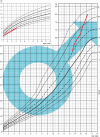Late diagnosis of DiGeorge syndrome in a 13-year-old male with subclinical course of the disease - case report and literature review
- PMID: 38282495
- PMCID: PMC10826693
- DOI: 10.5114/pedm.2023.132030
Late diagnosis of DiGeorge syndrome in a 13-year-old male with subclinical course of the disease - case report and literature review
Abstract
DiGeorge syndrome is associated with microdeletion of chromosome 22q11. Hypoplasia of the thymus, hypoparathyroidism, facial malformations and cardiac defects as well as learning difficulties are typical features of the disease. On the other hand hypocalcemia related to hypoparathyroidism is not present in every patient and can develop later and be persistent or transient and is often masked by the other signs or symptoms. We described a 13-year-old boy diagnosed with DiGeorge syndrome, after a few years of nonspecific signs and symptoms, and a microarray examination performed because myopathy was suspected on the basis of elevated creatine kinase activity. Only after molecular confirmation of DiGeorge syndrome the patient was referred to a pediatric endocrinologist and proper therapy started. Looking back to his medical history, low calcium levels were at least 2 times reported in the medical records, the child had learning difficulties, speech disturbances, and submucosal cleft palate suspicion. In conclusion it is important to educate general practitioners and pediatricians to check the serum calcium levels in patients presenting with nonspecific, muscular signs and symptoms.
Zespół DiGeorge'a jest związany z mikrodelecją w chromosomie 22q11. Typowymi cechami tej choroby są hipoplazja grasicy, niedoczynność przytarczyc, dysmorfia twarzy, występowanie wad serca oraz trudności w nauce. Hipokalcemia związana z niedoczynnością przytarczyc występuje tylko u części pacjentów. Może rozwijać się później niż inne objawy, być trwała lub przemijająca, a często zdarza się, że jest maskowana przez inne dolegliwości. W pracy prezentujemy przypadek 13-letniego chłopca, u którego rozpoznanie zespołu DiGeorge'a ustalono dopiero po kilku latach występowania niespecyficznych objawów. Badanie mikromacierzy zostało wykonane z powodu podejrzenia miopatii, wysuniętego na podstawie podwyższonej aktywności kinazy kreatynowej w badaniach laboratoryjnych. Dopiero po potwierdzeniu zespołu DiGeorge'a chłopiec został skierowany do endokrynologa dziecięcego i rozpoczął właściwe leczenie. Analiza historii medycznej pacjenta wskazuje, że w badaniach laboratoryjnych małe stężenia wapnia pojawiały się dwukrotnie, chłopiec miał trudności w nauce, opóźniony rozwój mowy, a także był podejrzewany o podśluzówkowy rozszczep podniebienia. Podsumowując – istotne jest, żeby uczulać lekarzy ogólnych oraz lekarzy pediatrów, aby zlecali badanie stężenia wapnia w surowicy u pacjentów z niespecyficznymi objawami ze strony układu mięśniowego.
Keywords: DiGeorge syndrome; Fahr's syndrome; hypocalcemia; hypoparathyroidism; myopathy.
Conflict of interest statement
none declared.
Figures
References
-
- Kułaga Z, Różdżyńska A, Palczewska I, et al. . Percentile charts of height, body mass and body mass index in children and adolescents in Poland–results of the OLAF study. Stand Med 2010; 7: 690–700.
Publication types
MeSH terms
Substances
LinkOut - more resources
Full Text Sources



